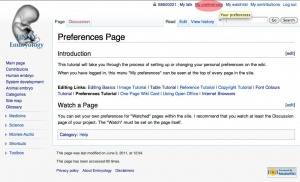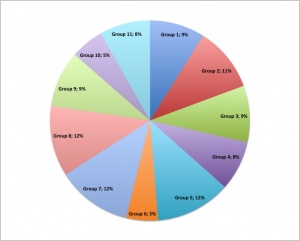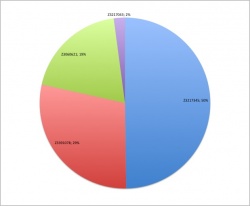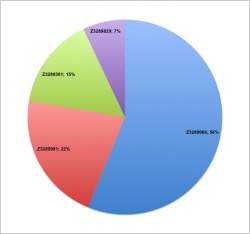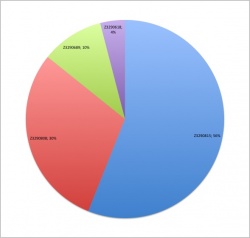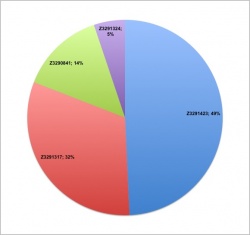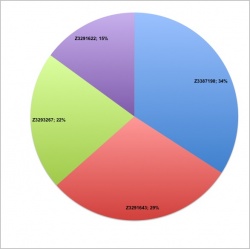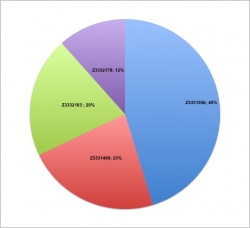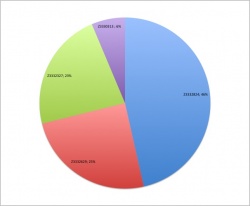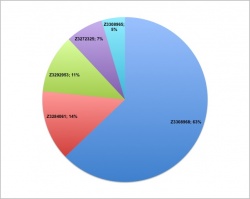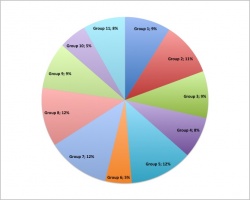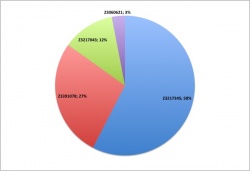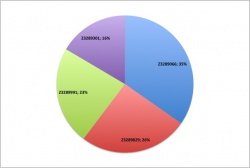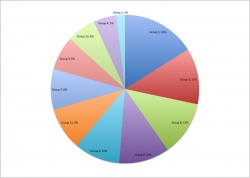ANAT2341 2011 Students
Group Assessment Criteria
- The key points relating to the topic that your group allocated are clearly described.
- The choice of content, headings and sub-headings, diagrams, tables, graphs show a good understanding of the topic area.
- Content is correctly cited and referenced.
- The wiki has an element of teaching at a peer level using the student's own innovative diagrams, tables or figures and/or using interesting examples or explanations.
- Evidence of significant research relating to basic and applied sciences that goes beyond the formal teaching activities.
- Relates the topic and content of the Wiki entry to learning aims of embryology.
- Clearly reflects on editing/feedback from group peers and articulates how the Wiki could be improved (or not) based on peer comments/feedback. Demonstrates an ability to review own work when criticised in an open edited wiki format. Reflects on what was learned from the process of editing a peer's wiki.
- Evaluates own performance and that of group peers to give a rounded summary of this wiki process in terms of group effort and achievement.
- The content of the wiki should demonstrate to the reader that your group has researched adequately on this topic and covered the key areas necessary to inform your peers in their learning.
- Develops and edits the wiki entries in accordance with the above guidelines.
Project Guidelines
- Divide the project into sections, that each member will work on.
- Later you can all work together on the entree project.
- Collect references, on your discussion page and prepare summaries.
- This will help others in the group understand what the paper is about.
- Collect images, on your discussion page that are correctly cited.
- plaigarism and copyright issues will affect your final group mark.
- Balance text and images, do not have too much of one or the other.
- Remember this is an online project and not an essay, hold the readers attention.
- Avoid Editing your project page simultaneously with other group members, this may crash the project page and make loading slow.
- Make small edits save regularly, do not leave the page open in edit mode for long periods.
- Organise times when you alone will be editing the project.
- Avoid Wikipedia sourced content, you are permitted a maximum of 1 image from that source and no derived text.
Plagiarism
Currently all students originally assigned to each group are listed as equal authors/contributors to their project. If you have not contributed the content you had originally agreed to, nor participated in the group work process, then you should contact the course coordinator immediately and either discuss your contribution or request removal from the group author list. Remember that all student online contributions are recorded by date, time and the actual contributed content. A similar email reminder of this information was sent to all current students.
Please note the Universities Policy regarding Plagiarism
In particular this example:
- "Claiming credit for a proportion of work contributed to a group assessment item that is greater than that actually contributed;"
Academic Misconduct carries penalties. If a student is found guilty of academic misconduct, the penalties include warnings, remedial educative action, being failed in an assignment or excluded from the University for two years.
Please also read Copyright Tutorial with regard to content that can be used in your project.
Editing Basics
I will be providing introductory tutorials at the end of early practical classes. The information shown in link below is available in the lefthand "Shortcuts" menu as Editing basics shown on every page.
Before you begin, follow these 5 steps and your contribution/project work will be much easier.
- Preferences Page begin by setting your own preferences, which will let you set up how your work will be acknowledged on this site (Undergraduate students should leave all associated identity information as your student number).
- Help:Editing Basics will explain how to make headings, lists and tables, which will help you understand how to do simple page editing. If you prefer to have a simple editing reference sheet, print out this linked One page Wiki Reference Card and use it when editing your project page.
- Help:Copyright Tutorial explains how to be legal, which will explain what you can add and how this should be referenced (Undergraduate students, remember the university policy UNSW Plagiarism and Learning Centre - Plagiarism information).
- Image Tutorial explains how to make your content interesting for viewers by adding images. This tutorial explains how to locate an image, prepare it for uploading, cite the source correctly, and also information on how the image can be positioned on the page.
- Reference Tutorial explains how you can acknowledge by citation the sources you have used for your content. This site uses two extensions that generate a reference list and format the reference for you.
Student Pages
Log in with student number and zpass.
Progressive Assessment
- The individual student assessment (20% of final mark) consists of a series of tasks allocated in lectures and practical classes.
- Items must be completed by the allocated time.
- Plagiarism of other student answers will result in a zero mark for that assessment item.
- All assessment items must include your signature and date stamp.
Student Group Projects
2011 Projects: Turner Syndrome | DiGeorge Syndrome | Klinefelter's Syndrome | Huntington's Disease | Fragile X Syndrome | Tetralogy of Fallot | Angelman Syndrome | Friedreich's Ataxia | Williams-Beuren Syndrome | Duchenne Muscular Dystrolphy | Cleft Palate and Lip
Quick Groups Assessment - 30 Sep
The following analysis of page editing was carried out on both the Project and Discussion page histories, up to and including Lab 10 after the peer assessment process.
Coordinator Skype status: <skype>mark_hill_unsw</skype>
Plagiarism
Currently all students originally assigned to each group are listed as equal authors/contributors to their project. If you have not contributed the content you had originally agreed to, nor participated in the group work process, then you should contact the course coordinator immediately and either discuss your contribution or request removal from the group author list. Remember that all student online contributions are recorded by date, time and the actual contributed content. A similar email reminder of this information was sent to all current students.
Please note the Universities Policy regarding Plagiarism
In particular this example:
- "Claiming credit for a proportion of work contributed to a group assessment item that is greater than that actually contributed;"
Academic Misconduct carries penalties. If a student is found guilty of academic misconduct, the penalties include warnings, remedial educative action, being failed in an assignment or excluded from the University for two years.
2011 Projects: Turner Syndrome | DiGeorge Syndrome | Klinefelter's Syndrome | Huntington's Disease | Fragile X Syndrome | Tetralogy of Fallot | Angelman Syndrome | Friedreich's Ataxia | Williams-Beuren Syndrome | Duchenne Muscular Dystrolphy | Cleft Palate and Lip
Group Project Page Edits
- The following table and graphs shows the total number of individual student project page edits (similar analysis is being made for the Group Discussion page).
- This is not an assessment of the content either added or removed (which will be analysed during the final assessment).
Group Discussion Page Edits
- The following table and graphs shows the total number of individual student discussion page edits.
- This is not an assessment of the content either added or removed (which will be analysed during the final assessment).
|
In the graphs, an equal edit contribution would be reflected by approximately similar sized wedges.
|
Group Project Lab 10
- Peer Assessment of your project should now appear on your group discussion page.
- Now you can make changes to your project based upon these reviews and your own concepts of how the project can be improved.
- At this time it is important that you interact with other group members to ensure they agree on the changes you may make.
- You may add additional content to your project.
- Look through the comments made by your peers and assemble a summary of good (positive) and bad (negative) feedback on your project.
- What are the common features of peer comments?
- Fix those minor problems (formatting, image size, image labelling, text, referencing)
- Are there parts of your project where group members have not worked appropriately or contributed their work?
- I will initially be discussing this with the groups individually. You will also have the opportunity to "feed back" contribution issues.
Group 9
Group 10
--Mark Hill 14:52, 1 October 2011 (EST)
- History section is all text.
- Reference list still contains multiple entries for same reference. I also think that a better reference could have been used that a book published back in 1987 (Duchenne Muscular dystrophy), I know for a fact that there are a large number of review articles which could have been used here.
- Some visual way of showing Epidemiology data perhaps.
- How about some normal muscle information or dystrophic muscle sections. The one figure you have included contains no helpful information other than the original figure legend and worst of all no reference citation.
- Who selected the crazy table colour scheme? Colour Tutorial
Group 11
--Mark Hill 15:36, 1 October 2011 (EST) I will need to speak to this group in Lab 11, please ensure that you are attending this class.
- As in my earlier comments (8 Sep) this project still requires substantial work, this is reflected in the many peer assessment comments. I had to look very hard to find comments that were even slightly positive, other than you had improved it since the previous quick assessment (8 Sep).
- A single student appears to be doing all the work on this project.
- There is little information about normal lip and palate formation.
- How does this figure Neuromeric Organization relate to cleft lip and palate?
- No information about environmental and genetic conditions leading to this clefting.
- No information about prenatal detection of clefting.
- Reference list still contains multiple entries for same reference.
Quick Group Assessment - 8 Sep
Well I have had a quick look through the projects as they stand today and I must say you have a long way to go yet! There was evidence that some students had spent some time researching their topic, while others had not even submitted their subsection text yet. In particular poorly structured, repetitive, unexplained terminology and verbose text is always bad to see. I also noted a distinct absence of uploaded figures and student drawn images in many project pages. I have also included some reference search strategies, as clearly some of you have not looked through the literature for resources. Have a look through my brief comments and see whether they give you some idea where to go next.
--Mark Hill 16:28, 8 September 2011 (EST)
Uploaded Student Images - Please include the following template in all uploaded image information. Copy the text shown below including the curly brackets in page view mode, and paste at the end of the information box area when uploading your image.
{{Template:2011 Student Image}}
Project Layout Tutorials
| Editing Links: Editing Basics | Images | Tables | Referencing | Journal Searches | Copyright | Font Colours | Virtual Slide Permalink | My Preferences | One Page Wiki Card | Printing | Movies | Language Translation | Student Movies | Using OpenOffice | Internet Browsers | Moodle | Navigation/Contribution | Term Link | Short URLs | 2018 Test Student |
Group 1
--Mark Hill 10:44, 8 September 2011 (EST) Some of the existing sub-sections have appropriate content, but there are also empty sub-sections, a total lack of referencing/citation and no glossary.
- The referencing issue needs urgent progress.
- Existing figures/table are appropriate. Table appears to be directly used from an uncited source.
- There needs to be more images in this work. If you do not know where to put the images yet, place them between gallery tags.
- Where is the student drawn figure?
Biomed Central 1566 items found = 1465 research articles + 101 other articles (reviews etc.)
Entrez
http://www.ncbi.nlm.nih.gov/sites/gquery?term=Turner%20Syndrome
Group 2
--Mark Hill 10:54, 8 September 2011 (EST) There seems to be some good progress on the project.
- It would have been better to blank (black) the identifying information on this ultrasound.
- Historical Background would look better with the dates in bold first and the picture not disrupting flow (put to right).
- None of your figures have any accompanying information or legends.
- The 2 tables contain a lot of information and are a little difficult to understand. Perhaps you should rethink how to structure this information.
- Currently very text heavy with little to break up the content.
- I see no student drawn figure.
- referencing needs fixing, but this is minor compared to other issues.
Biomed Central 141 items found = 124 research articles + 17 other articles (reviews etc.)
Entrez
http://www.ncbi.nlm.nih.gov/sites/gquery?term=DiGeorge%20Syndrome
Group 3
Group 3 - Klinefelter Syndrome
--Mark Hill 14:36, 8 September 2011 (EST) Good sub-heading structure and overall draft text layout. Some sections very content poor, who was working on Diagnosis and Current Research? In particular where are all the figures???
- Introduction- you have the content there, but it reads very poorly in structure. You should try and fix this. Remember the introduction is the first thing that people will read. Also good to have some figure to interest the reader. There are also lots of clinical terms that may not be understood by the average undergraduate student.
- History - There are only 3 worthy features in the history of this disease? You have not done the work here. This should perhaps also be structured as a timeline, bullets date first in bold.
- Epidemiology - read the first sentence, its not English. The next section also is not very clear. I think this whole section should be looked at again in terms of structure and clarity.
- Signs and Symptoms - this should illustrate some of these Signs and Symptoms, not the genital features please.
- Diagnosis - OK this is sort of a description for Karyotyping, but it is not complete or accurate description of the method. Look it up please and fix this.
- Etiology - this is not a description of non-disjunction, which is what this section should be about.
- Pathogenesis - first sentence is repetition of previous sections, this should have been fixed by now so that the same content does not appear in multiple sub-headings.
- Case Study- I don't think you need this section.
- Other Similar Defects -first identify why they are similar, then explain how you will describe in a table.
- Current Research - very poor. Who in the group should have done this section?
Biomed Central 68 items found = 64 research articles + 4 other articles (reviews etc.)
Entrez
http://www.ncbi.nlm.nih.gov/sites/gquery?term=Klinefelter%20Syndrome
Group 4
Group 4 - Huntington's Disease
--Mark Hill 15:01, 8 September 2011 (EST) Good sub-heading structure, as I have discussed this will be postnatal rather than prenatal effects, so diagnosis should be covered in some depth. Content in some sections is still very light and not researched. Currently there is not a single figure on the project page.
- Introduction - brief and to the point. There are some terms that may require clarification (cerebral cortex, striatum, chorea). There is no mention of it belonging to a group of known disease types.
- History - This is a genetic disease, it probably had "existed" before the seventeenth century, this was when it was described. It appears that there is only a single time point (the discovery) in the history of this disease, fix this please. khoreia should be in italics.
- Epidemiology - "white people as compared to Africans and Asians" is this the correct terminology? The country by country information would look better in the form of a table. "HTT haplotypes" without any explanation. Sub-headings would fix some of the disjointed feel to this section.
- Pathogenesis and Genetics - same content, with typos. Typos suggest that you (or your group) have not reviewed the work. This is a very poor sub-section.
- Diagnostic Tests - "the middle ages" as opposed to the medieval period? These "similar diseases, which mimic similar characteristics" need to be better organised to show how they are similar. Neuropathology, is this not a postmortem diagnosis?
- Clinical Manifestations - no text here.
- Treatment - a list of bullet points with no accurate descriptions of these treatments. Breakthroughs, is this not Current/Future Research?
- Current/Future Research - Nothing here of interest nor referenced.
Biomed Central 4564 items found = 4225 research articles + 339 other articles (reviews etc.)
Entrez
http://www.ncbi.nlm.nih.gov/sites/gquery?term=Huntington's%20Disease
Group 5
--Mark Hill 15:06, 8 September 2011 (EST) This is a reasonable start, you have identified most key topic issues. The formatting of your subheadings is all wrong. There is currently not a single figure, illustration or table in this project. There should at least be something showing the gene, location and genetic mutation.
<wiki>=Fragile X Syndrome = </wiki>
then
<wiki>==Introduction == </wiki>
and so on through all sub-headings, with appropriate sub-sub headings or bullet/numbered lists.
- Introduction - should be just that and be before history of the disease section. Fix this.
- History of the disease - just history will be fine. The writing is not very clear you need to go through this and restructure, perhaps by someone else not the original author who may not see the problems. Really, only 3 parts to the history of this disease, you have not done your research.
- Epidemiology - The first part of this text looks to have come directly from (http://www.cdc.gov/genomics/resources/books/HuGE/chap23.htm), not good enough. The (CGG) expansion has not even been explained.
- Etiology - Reasonable description, but this section could be illustrated with what you are trying to describe.
- Development of the Disease - Fetal not Foetal please. "evincing" remember your audience is university level student. Hoeft et al. (2010), place the citation directly after date. Postpubescent, where is the reference for what you are stating here.
- Signs and Symptoms - OK here, not the best, but better than other parts of the project so far.
- Recent Research - Rapin & Tuchman, (2008), place the citation directly after date. Diagnosis and Treatment, should this not have been in another section? Does not sound like recent research. This whole section needs some structural work.
Biomed Central Fragile X (exact phrase) in all fields 263 items found = 247 research articles + 16 other articles (reviews etc.)
Entrez
http://www.ncbi.nlm.nih.gov/sites/gquery?term=Fragile%20X
Group 6
--Mark Hill 15:50, 8 September 2011 (EST) This has reasonable sub-heading structure, but several sections still lack any content, which they should by now. There are only 2 figures and the text in places is verbose, and very poorly structured for ease of reading/understanding.
- Introduction - No text here? This is where the reader starts and it should grab their attention to your topic.
- History - Good early background. Quoted text should be indented. You have included only a few time points in the disease up to 1945-50's and only broadly thereafter. The text is also very clinically technical, suggesting that you have just copied without understanding the content itself.
- Signs and Symptoms - this should have subsections for each description.
- Genetics/Aetiology - No text here?
- Pathophysiology and Abnormalities - Seems to overlap with the Signs and Symptoms content.
- Diagnostic Tests - you name the tests but do not describe how they work or what they show, this could easily be illustrated.
- Treatment/Management - I think this should be far better structured in layout and content.
- Prognosis - No text here?
- Future Directions - No text here?
Biomed Central 195 items found = 188 research articles + 7 other articles (reviews etc.)
Entrez
http://www.ncbi.nlm.nih.gov/sites/gquery?term=Tetralogy%20of%20Fallot
Group 7
--Mark Hill 13:42, 8 September 2011 (EST) Good overall layout in terms of sub-headings, but still feeling very incomplete.
- History - which version are you using text or table? don't have the same content twice.
- Epidemiology - very poor content. Who was doing this section?
- Aetiology - chromosome image is useful here. If you include tables, you need to refer to them within the text and why is the table reference in this section?
- Pathogenesis - a good section, ext could be simplified in structure. Includes a student drawn image, though no description to what each of the blocks and orange blobs are meant to represent.
- Animal models - fix the numbered formatting. Text reads like it has come directly from a paper.
- Signs and Symptoms - seems out of place located here and the content is a little jumbled about.
- Complications
- Differential Diagnosis - should this be a sub-heading of Diagnosis?
- Genetic Counselling - same comment as for first table. How is this adapted it looks pretty much the same to me.
- Current and Future Research - nothing in this section.
- Notable people with Angelman Syndrome - is this relevant as a sub-heading?
- Glossary - incomplete and does not include any acronyms.
Biomed Central 106 items found = 101 research articles + 5 other articles (reviews etc.)
Entrez
http://www.ncbi.nlm.nih.gov/sites/gquery?term=Angelman%20Syndrome
Group 8
--Mark Hill 13:40, 8 September 2011 (EST) A well-structured project in terms of sub-headings. Student drawn image included on project page. The problem, like all other projects, is a lack of section illustrations and figures. It currently just looks like a lot of writing, with each section slightly differently formatted.
- Timeline - would look better vertical rather than horizontal.
- Epidemiology - numbering should be either bullets or not at all. 1-3 and the separately Morbidity & Mortality?
- Clinical Presentation - too many sub-sub headings, rationalise structure.
- Postnatal Diagnosis - table formatting should be fixed.
- Treatment - the text is poorly written/structured, go through this and organise to make sense.
- Current Research - no text, a simple PubMed search would show you what is going on now.
- Glossary - does not include all terms and acronyms used in the project.
Biomed Central (exact phrase) in all fields
50 items found = 47 research articles + 3 other articles (reviews etc.)
Entrez
http://www.ncbi.nlm.nih.gov/sites/gquery?term=Friedreich's%20Ataxia
Group 9
--Mark Hill 13:09, 8 September 2011 (EST) This is a good start in the way of sub-heading structure. The current problem is that many of these sub-headings contain no content. A previous individual assessment was to insert your text on the project page, someone has either not added their text or their are unallocated sections. Either way it makes the project look very unfinished in places. More importantly at this stage is the lack of any related images or student illustration.
- Introduction - should be more a brief text intro rather than bullet points here.
- History of the disease - "William-Beuren Syndrome is named after John C.P. Williams," perhaps you should start with this. Timeline, this sub-sub heading has no text.
- Genetic factors and Etiology - could indicate the region deleted in an image.
- Diagnosis - there is a list of descriptions that should be illustrated. seems to be an overlap with the following section (Physical Characteristics).
- Physical Characteristics - there is no text in this section.
- Epidemiology - shod be linked earlier to diagnosis.
- Glossary - no descriptions. Should include all acronyms used (FISH, STR etc).
- Referencing - formatting seems to be applied well, I have not checked at this stage that all content is correctly cited.
Biomed Central 4564 items found = 4225 research articles + 339 other articles (reviews etc.)
Entrez
http://www.ncbi.nlm.nih.gov/sites/gquery?term=Williams%20Syndrome
Group 10
--Mark Hill 12:40, 8 September 2011 (EST) There is a backbone here for content to be built upon, but many sections still lack adequate work. I would have expected more by this stage in your work.
- There are no images added to the project page. I would have thought at least dystrophin gene, mutation hotspots, abnormal muscle, etc.
- History/timeline - just a single entry and nothing about the entire history of this disease.
- Epidemiology - why does it occur at this rate?
- Aetiology - Genetics - you have used a single review source for most of your information, without locating and identifying the research literature.
- If you intend to use the same reference more than once use the following format (without the wiki): <ref name="PMID21810612"><pubmed>21810612</pubmed></ref> it will then appear as a single entry in your reference list.
- Clinical manifestations and complications - fix the sub-sub-heading format, I do not like asterisks and italics, keep it simple.
- Diagnosis - you could not find a suitable illustration for this point?
- Treatment: Current and Future Prospects - Future Therapies is currently a list of terms with no adequate descriptions.
- Minor point - references should appear after the full stops.
- 2 case studies? get rid of this unless you have something to say here.
- Where is the student drawn illustration?
- Glossary - descriptions are inadequate, and in some cases just wrong.
Biomed Central Duchenne in all fields 325 items found = 301 research articles + 24 other articles (reviews etc.)
Entrez
http://www.ncbi.nlm.nih.gov/sites/gquery?term=Duchenne%20Muscular%20Dystrophy
Group 11
--Mark Hill 12:11, 8 September 2011 (EST) This project shows extremely poor progress at this time. May empty sub-sections and many of you have not met the requirements as required in an earlier laboratory assessment to add your content to the project page. Given the scope of your project topic there are an enormous number of resources, which have not been researched or utilised.
- Timeline would look better as bullet points with the date in bold as the first text.
- Only figure added is incorrectly named File:Pierre-Joseph_Desault-jpg.jpg. I had previously contacted and asked for this to be fixed and a citation added, neither has been done.
- I cannot provide you any further constructive comments at this stage, because there is insufficient for me to work with.
Biomed Central
Cleft Palate (exact phrase) in all fields
228 items found = 214 research articles + 14 other articles (reviews etc.)
Entrez
http://www.ncbi.nlm.nih.gov/sites/gquery?term=Cleft%20Palate
http://www.ncbi.nlm.nih.gov/sites/gquery?term=Cleft%20Lip
2010 Diagnostic Techniques
Project 1 - Ultrasound | Project 2 - Chorionic villus sampling | Project 3 - Amniocentesis | Group Project 4 - Percutaneous Umbilical Cord Blood Sampling | Project 5 - Fetal Fibronectin | Project 6 - Maternal serum alpha-fetoprotein | Related page - Prenatal Diagnosis
2009 Animal Models
Project 1 - Rabbit | Project 2 - Fly | Project 3 - Zebrafish | Group Project 4 - Mouse | Project 5 - Frog | Related page - Animal Development
Co-ordinator Note
Dr Mark Hill |
ANAT2341 Embryology S2 2011
|
Course Content 2011
2011 Timetable: | Embryology Introduction | Fertilization | Cell Division/Fertilization | Week 1 and 2 Development | Week 3 Development | Week 1 to 3 | Mesoderm Development | Ectoderm, Early Neural, Neural Crest | Trilaminar Embryo to Early Embryo | Early Vascular Development | Placenta | Vascular and Placenta | Endoderm, Early Gastrointestinal | Respiratory Development | Endoderm and Respiratory | Head Development | Neural Crest Development | Head and Neural Crest | Musculoskeletal Development | Limb Development | Musculoskeletal | Renal Development | Genital | Kidney and Genital | Sensory | Stem Cells | Stem Cells | Endocrine Development | Endocrine | Heart | Integumentary Development | Heart and Integumentary | Fetal | Birth and Revision | Fetal
Glossary Links
- Glossary: A | B | C | D | E | F | G | H | I | J | K | L | M | N | O | P | Q | R | S | T | U | V | W | X | Y | Z | Numbers | Symbols | Term Link
Cite this page: Hill, M.A. (2024, April 27) Embryology ANAT2341 2011 Students. Retrieved from https://embryology.med.unsw.edu.au/embryology/index.php/ANAT2341_2011_Students
- © Dr Mark Hill 2024, UNSW Embryology ISBN: 978 0 7334 2609 4 - UNSW CRICOS Provider Code No. 00098G
